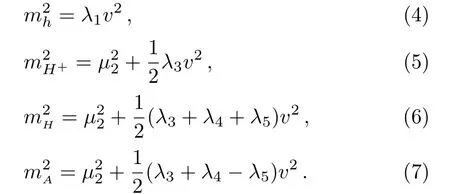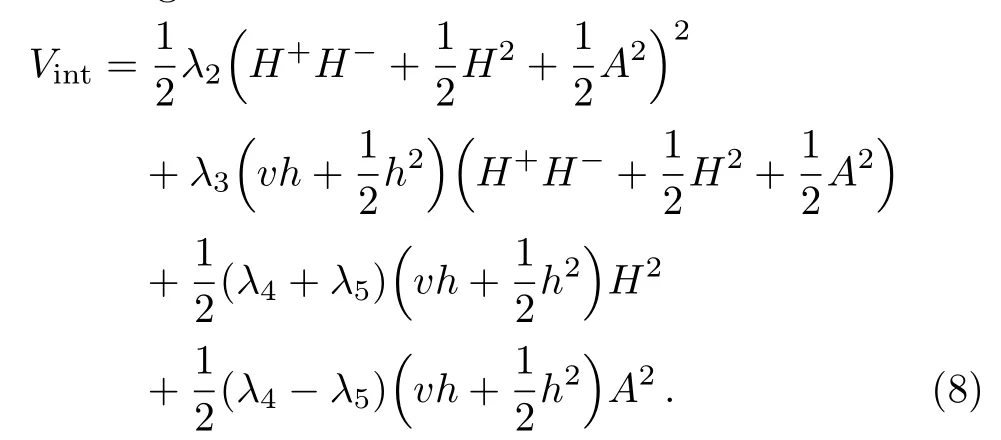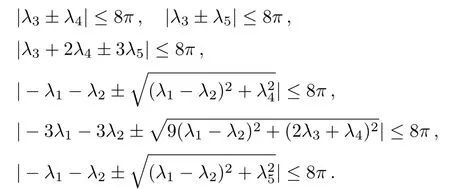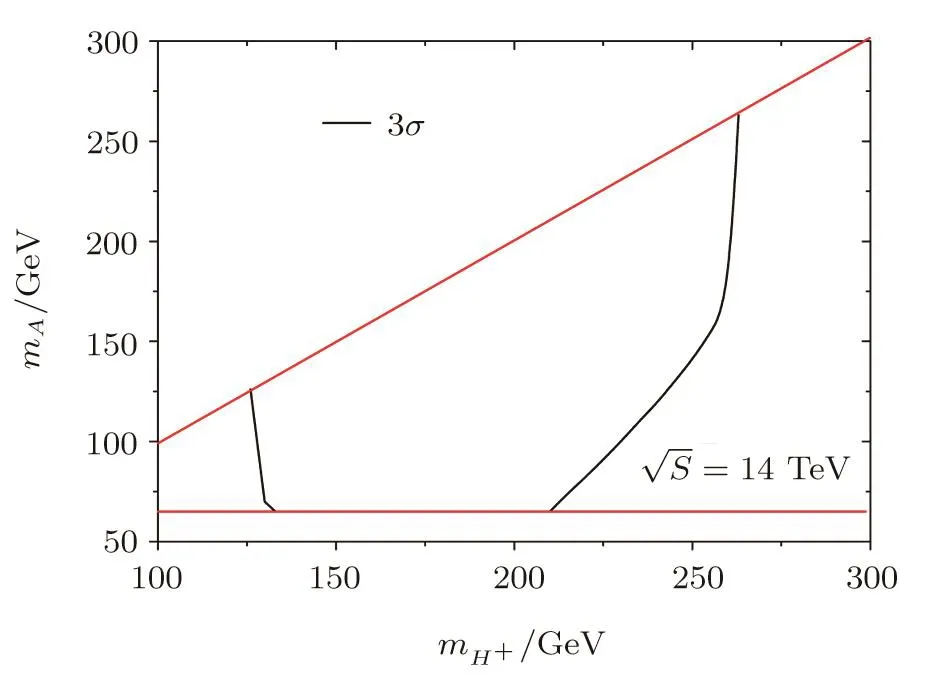Searches for Dark Matter via Mono-W Production in Inert Doublet Model at the LHC?
Neng Wan(萬能),Niu Li(李牛),Bo Zhang(張波),Huan Yang(楊歡),Min-Fu Zhao(趙敏福), Mao Song(宋昴), Gang Li(李剛),and Jian-You Guo(郭建友)
1Center of Basic Experiment,West Anhui University,Lu’an 237012,China
2School of Physics and Material Science,Anhui University,Hefei 230039,China
1 Introduction
The astrophysical and cosmographic observational evidences have confirmed the existence of dark matter(DM)and provided the DM density in the universe.[1]However,these observations do not tell us more detailed information about the mass of DM particle or whether it interacts with the Standard Model(SM)particles.Determining the nature of DM particle quantitatively is one of the most important tasks both in cosmology and particle physics.Among all the DM candidates,weakly interacting massive particles(WIMPs)is a promising scenario.This is due to that it offers the possibility to interpret the relic abundance for the DM as a natural deduction of the thermal history of the universe.[2]
Among various theoretical models,the inert doublet model(IDM)is one of the simplest models for the WIMP dark matter scenario,in which an isospin doublet scalar field is added to the SM Higgs sector and the corresponding field is assumed to be odd under an unbroken discrete Z2symmetry.After electroweak spontaneous symmetry breaking,there are four Z2odd scalar particles,i.e.,the CP-even H,the CP-odd A and two charged H±scalar bosons.The Z2symmetry ensures that the doublet Φ2fields do not spontaneously decay into final states including only the SM particles.Among them,the lightest scalar particle may serve as a dark matter candidate if it is electrical neutral.In addition,the additional doublet Φ2does not interact with the Standard Model fermions at tree level.Their interacts with the Standard Model are achieved via gauge interactions and via the quartic term with the Higgs doublet in the scalar potential.These terms are important in the phenomenology for searching the IDM.
The lightest scalar Higgs,as a candidate for dark matter,has been studied in extensive literature.[3?9]In Ref.[10],it is found that three mass regions of the inert scalar Higgs can get the correct thermal relic abundance.The dark matter direct detection and indirect detection experiments report their results recently,and not find any dark matter particle signal.This gives more stringent restrictions on the parameters of the IDM model.From the direct detection experiments,the mass of dark matter particle in the IDM has been constrained to two regions:around a half of the Higgs boson mass(125 GeV)in the low mass region or above about 500 GeV in the high mass region.[11?16]
High energy colliders may also be a useful tool to search the dark matter particle in the IDM.In order to maintain Z2symmetry,Z2odd scalar particles always generate in pairs at high energy colliders.The lightest scalar particles of the IDM will become a dark matter candidate particle,other scalar particles will eventually decay into the lightest scalar particles and SM particles,such as A→ HZ,H±→ HW±.Thus,the final particles in high energy colliders can be observed as dark matter particles and W,Z associated production.Especially,the primary production processes including IDM effect are HHW and HHZ production.Dark matter associated a dilepton/dijet production in the IDM at hadron colliders has been studied in Refs.[12,17–22],where missing ETfollowing A→ HZ(?)(H±→HW±)from HA(H+H?)production and assuming that the CP-even scalar H is a dark matter candidate.This process can be used to measure the mass of all new scalars with statistical precision of the order of few hundred MeV at future e+e?colliders.[23?24]In this paper,we will investigate CP-even scalar H pairs associated a W boson production in the IDM at the LHC.
The paper is arranged as follows:in Sec.2 we briefly describe the related simplified model and present the calculation strategy.In Sec.3,we summarize all the theoretical and phenomenological constraints on the scalar potential for the IDM.In Sec.4,we present some numerical results and discussion.Finally,a short summary is given in Sec.5.
2 The Inert Higgs Doublet Model
The Inert Higgs Doublet Model is an extension of Standard Model(SM),which contains two Higgs doublets Φ1,2and a discrete Z2symmetry.Under Z2symmetry,the Higgs doublet fields are defined by Φ1→ Φ1,Φ2→ ?Φ2.All the SM fields are invariants under the discrete Z2symmetry,and Φ1is almost the same as the SM Higgs doublet.The extension scalar sector of the IDM contains a complex isospin doublet field Φ2with hypercharge Y=1/2,which like the SM Higgs doublet field Φ1.The inert doublet field Φ2is odd under a discrete Z2symmetry.Under the electroweak symmetry SU(2)L×U(1)Yand the unbroken discrete Z2symmetry,the Higgs potential is given by

In the CP-conserved case,all the parameters are considered to be real.The coupling constants should satisfy the theoretical constraints,such as vacuum stability[25?26]and perturbative unitarity.[27?28]The requirement of vacuum stability is present below,

The coupling constants constraints from perturbative unitarity are given in Refs.[27–28].In the case with exact Z2symmetry,Φ2does not need any non-zero vacuum expectation value(VEV),and therefore,only the SM field,Φ1takes part in the electroweak symmetry breaking(EWSB).After the EWSB,the doublet scalar fields are parameterized as

where h is the SM Higgs boson with the mass 125 GeV,v is the vacuum expectation value(VEV)with 246 GeV,and G+and G0are Nambu-Goldstone bosons,which are absorbed into the longitudinal components of the W and Z bosons.We call the other Z2odd scalar bosons H,A,H±as the inert scalar bosons,where H is neutral scalar,A is a neutral pseudoscalar,and H±are two charged Higgs bosons.After applying the stationary condition,the masses of scalar bosons are given by

The interaction vertices among the Standard Model Higgs boson h,the inert scalar bosons H±,H,and A are the following:

Being electroweak doublets,they also have gauge interactions,but they do not interact directly with quarks or leptons.
Assuming the mass hierarchy mH±>mA>mHfor the inert scalar bosons,the stable H appears as missing energy after the decays of A and H±.Since there is no term linear in A or H in Eq.(8),the decay of A only occur through the gauge interaction

As for H±,its gauge interactions with H and A are given by

Hence the dominant decays of H±are into W±H and W±A,then the inert scalar A subsequently decays to ZH.
The IDM scalar sector can be specified by a total of six free parameters:

We introduce the useful abbreviations λl=(1/2)(λ3+λ4+ λ5)and λs=(1/2)(λ3+ λ4? λ5).Through the above equations,the six parameters can be changed into a set of more meaningful parameters,

3 Constraints on the Model Parameters
In this section,we summarize all the theoretical and phenomenological constraints on the scalar potential,which are included in the scan of the parameter space of the IDM.
First of all,perturbative unitarity for IDM requires that all coupling parameters should be less than 4π.[29]

Secondly,the physical vacuum of the scalar potential should be stable,which requires[30?32]

The S-matrix unitarity of 2→2 scalar scattering matrix at tree level requires the scalar coupling satis fi ed that[33?34]

The global electroweak fit through the oblique S,T,U parameters is a common approach to constrain new physics beyond SM.When the parameters S,T,U remain in the region?S=0.03±0.09,?T=0.07±0.08(?U is fixed to zero),the authors have calculated the contributions of the oblique parameters for IDM in Ref.[35].The results show that the mass splitting among the scalar particles in the IDM can not be large,even if the mass of H0reaches 500 GeV.[36]
Besides above theoretical constraints on the parameters of the IDM,the high energy collider also gives the experimental limits to this model.The experimental limitations at LEP first come from the measurements of Z→AH,Z→H+H?,W±→AH±and W±→HH±decay,and the results show that there are no signals beyond the standard model.As a good approximations,these imply that the mass of these scalar particles must be satisfied:MA0+MH0≥MZ,2MH±≥MZ,MH±+MH,A≥MW.Secondly,a model-independent lower limit for the mass of the charged scalars is provided from chargino searches at LEPII:MH±&70 GeV.[37]Searches for charginos and neutralinos at LEPII also provide the bound on MH:if MH<80 GeV then MA?MHshould be<8 GeV,or else,MAshould be>110 GeV.[38]
The experimental limitations at the LHC mainly come from the decay of Standard Model Higgs.In the IDM,the new scalar fields affect the width of Higgs decay to diphoton or the Higgs invisible decay branching ratio.[35,39?41]The limits from the new scalar and SM Higgs coupling require the new scalar boson masses below Mh/2,and this has little limitation for the scalar particles mass above Mh/2.Direct dilepton decay have also been used to restrict the scalar particle mass in the region of MH.60 GeV and MA.150 GeV.[21,42]
From above constraints,we find that the IDM is strongly restricted if the new scalar particle masses are at sub 100 GeV and not strict constrained above 500 GeV.In addition,the astrophysical constraints are reviewed in Ref.[31].
4 Signal and Background
In this section,we perform the Monte Carlo simulation and explore the sensitivity of 14 TeV LHC through the channel,

where ?=e,μ.The lightest scalar particle H,as a candidate of dark matter,will escape the detector as the missing energy.The W boson is reconstructed using its leptonic decays into electron or muon and corresponding neutrino.The typical Feynman diagrams of production and decay chain are presented in Fig.1.We can see that this process can be used to probe the hHH,H+W?H and HHW+W?coupling.
The Feynman Rules are extracted by the package FeynRules[43]from the Lagrangian of IDM.These Feynman Rules are generated into Universal FeynRules Output(UFO) files[44]and then add into the Monte Carlo event generator MadGraph@NLO(MG5)[45]for the generation of event samples.All the signal and backgrounds events are generated at LO with the CTEQ6L parton distribution function(PDF)and the renormalization and factorization scales are set dynamically by default along with basic acceptance cuts employed.PYTHIA6[46]is utilized for parton shower and hadronization with the options of ISR and RSR included.Delphes[47]is then employed to account for the detector simulations with the CMS card and MadAnalysis5 for analysis,where the(mis-)tagging efficiencies and fake rates are assumed to be their default values in Delphes,which is formulated as a function of the transverse momentum and rapidity of the jets.The anti-ktalgorithm[48]with the jet radius of 0.5 is used to reconstruct jets.The IDM mediator width is automatically computed by using the MadWidth module for each parameter point.The SM input parameters relevant in our work are taken as:

We choose{mH±,mA,mH,mh,λl,λ2}as the input physical parameters:mH±,mA,mHare the Z2odd scalar particles masses,the couplings λ2and λlcorrespond to self-interaction in the dark sector and interaction between the dark matter and SM-like Higgs boson,respectively.Considering all the dark matter and collider constraints available presently,the following benchmark points(BP)are selected for our study as in Ref.[22],which is based on the the work in Refs.[18,49].
Benchmark Points are listed in the Table:


Fig.1 The Feynman diagrams for process pp→HHW±in IDM including the leptonic decay of W boson.
The mass of the SM-like Higgs particle is always set to the value Mh=125.1 GeV.We have fixed the mass of the dark matter candidate to be mH=65 GeV,in order to avoid the invisible decay of the SM Higgs boson to a pair of DM.However,we have confirmed that,varying the mass slightly,within the window available,as described above does not bring in any significant change in our conclusions.We have then chosen different representative values of mH+,the main object of our study.This then naturally limits the value of mAto be close to mH+.The values considered in the BP’s are obtained from a random scan,satisfying all the dark matter and collider constraints mentioned above.The cross sections of the lightest scalar particle H pair associated a W boson production at the LHC with=14 TeV for these benchmark points are given in Table 1.
Table 1 The cross sections of the pp → HHW±(→ l±ν)production in the IDM at the LHC with=14 TeV for these benchmark points are given.

Table 1 The cross sections of the pp → HHW±(→ l±ν)production in the IDM at the LHC with=14 TeV for these benchmark points are given.
BP1 BP2 BP3 BP4 BP5 BP6 σ/fb 0.1523(2)70.5(1)25.00(3) 7.166(8)2.774(3)1.322(2)
4.1 Background
The primary source of background for the signal is come from the SM W → ?ν decays with ?=e,μ.Meanwhile,a W → τν sample,where the τ-lepton decays to an electron or a muon,can not be separated from prompt leptons and missing energy.Top-quark pair production is another source of high-pTleptons andMultijet background(QCD),enriched in electrons/photons and muons,has by far the largest cross section,it is efficiently rejected by the isolation requirements imposed to select the lepton candidates as well as the requirement on the ET.Despite the large suppression of these events,the misidenti fi ca-tion of jets as leptons(especially as electrons)still occurs.Drell-Yan production of dileptons(?=e,μ)constitutes a background when one lepton escapes detection.Contributions from Dibosons(WW,WZ,ZZ)decaying to a state with at least one lepton can not be ignored.In the electron channel,a γ+jet event sample is used to estimate the e ff ects of photons misidentified as electrons,which are largely rejected by the requirement of two-body decay kinematics.
In our simulation,we generate 100,000 events for the signals and 100,000 events for all the backgrounds.We fi rst employ some basic cuts for the selection of events:

whereand ηj,lare the transverse momentum and the pseudorapidity of the jet and leptons,respectively.is the particle separation among the objects(the jet,the lepton,and the photons)in the final state with??,and?η being the separation in the azimuth angle and rapidity,respectively.The ηl,jacceptance region avoids the gap between barrel and endcap,where the misidentification probability is the highest.

Fig.2 (Color online)Normalized distributions of numbers of lepton N(?)and b quark N(b),the transverse missing energy ET,the azimuthal angle between the directions of the missing transverse energy ??(?,ET),the leptonic transverse momentum ,the ratio of /the total transverse hadronic energy HT;and the transverse mass of lepton-ETsystem MT(?,in the signals and backgrounds at 14 TeV LHC.
According to the distribution differences between the signal and backgrounds,we can improve the ratio of signal to backgrounds by making suitable kinematical cuts.Through the investigation,we find that the backgrounds of W decay to τ-lepton,Multijet(QCD)and γ+jet event are suppressed seriously after suitable cuts,and can be neglected.Therefore,we will not list the these three backgrounds in the following analysis.In Fig.2,we show the distributions of some kinematical variables for the signal and backgrounds at 14 TeV LHC.N(?)and N(b)are the numbers of lepton and b quark. The total transverse hadronic energy HTis a global observable,which is defined by

In the leptonic decay channel,the kinematic variable transverse mass of the lepton-ETis defined,

where ??l,ETis the azimuthal opening angle between the directions of the missing transverse energy and the charged lepton. The distributions of the observable MT(?,ET),ETand PT(l)are similar.In fact,these variables are not completely independent.We only need to chose one of them,then select the suitable cut to suppress the SM backgrounds.From Fig.2,we find the total transverse hadronic energy HTcan significantly reduce all the SM background except ttˉ background.The ttˉ background can not be suppressed by changing other observables,such as MT(?,ET),ET,PT(l).We first select the events with N(l)=1,N(b)=0.Through requiring the number of final state only one lepton and one b quark,we can suppress amounts of Standard Model backgrounds,especially the background of top-quark pair production.Next,we require the total transverse hadronic energy HT>150 GeV.All the SM backgrounds are suppressed seriously.Finally,we require the transverse missing energy ET>40 GeV to improve the discovery significance
For a short summary,we list all the cut-based selections here:
(i)Basic cut:pjT>25 GeV,p?T>20 GeV,|ηj|<2.5,|η?|<2 and ?Rij>0.4(i,j= ?,j,γ).
(ii)Cut 1 means the basic cuts plus missing N(?)=1 and N(b)=0.
(iii)Cut 2 means Cut 1 plus requiring the total transverse hadronic energy HT>150 GeV.
(iv)Cut 3 means Cut 2 plus requiring the transverse missing energy ET>40 GeV.

Table 2 The number of events for the signal(HHW)in BP2 and backgrounds(W → ?ν,tˉt,DY and Diboson)after the cut flows are listed in the brackets at the 14 TeV LHC with integrated luminosity L=3000 fb?1.The values of discovery significance S at each step of cut are also shown.
The results of the number of events(with luminosity=3000 fb?1)are shown in Table 2 at each step of cut.The values of the discovery significanceare also shown,where S and B are the numbers of signal and total background events,respectively.From the result in the table,we find that the backgrounds mainly come from W lepton decay channel in SM.After applying all select cuts,the backgrounds can be reduced to ten thousandth.For the BP2,the discovery significancecan reach 19.26σ.Thus,we can observe the IDM effect though the neutral scalar H pair associated W in some parameter space with large luminosity at the 14 TeV LHC.The statistical significance are affected significantly by the systematic error.If the systematic error is considered,the statistical significance uncertainty needs to be added to this part,which is defined(S??B)/(2(S+B)3/2),where?B is the systematic error on the background number of events.If we take?B as 5%of the background number of events,statistical significance uncertainty will arrive 0.484 after cut 3 in Table 2.

Fig. 3 (Color online) Contour plots in plane mH+ ?mA with 3σ discovery significance for process pp → HHW production at 14 TeV LHC with integrated luminosity of 3000 fb-1.
In Fig.3,we plot the 3σ discovery reach in the plane mH+?mAwith the integrated luminosity of 3000 fb?1.we investigate the effects of coupling parameter λ2and λLand find that the cross section has little change with the varying λ2and λL.In this paper,we assume the mass hierarchy mH±>mA>mH.As in the previous benchmark points,we set the lightest scalar Higgs mH=65 GeV.Thus,the minimal value of mAis 65 GeV,the maximal value of mAis equal mH±.In Fig.3,The two red lines represent the line mH+=mAand mA=65 GeV.The other two black lines are the 3σ discovery limit.From Fig.3,we find that,in the range of 120 GeV The origin of dark matter is one of the most compelling mysteries in our understanding of the universe now.High energy colliders provide ideal facilities to search for DM particle.The Inert Doublet Model,which is one of the most simple extension of the Standard Model,provides a scalar DM particle candidate.In this paper,we have studied the lightest scalar particle H pair associated a W boson production in IDM at the 14 TeV LHC,in which H is the DM particle,W will decay to leptons or hadrons.We focus on the leptonic channel of W boson.The SM main backgrounds include single W leptonic decay,top pair production,Drell-Yan process,and Diboson leptonic decay.We implemented the Multivariate Analysis(MVA)method for selecting suitable cuts to suppress these SM backgrounds and improve the discovery significance.We also gave the contour plots in plane mH+?mAwith 3σ discovery significance at 14 TeV LHC with integrated luminosity of 3000 fb?1and found that it has potential for observing the mono-W signal in the range of 120 GeV [1]G.Bertone,D.Hooper and J.Silk,Phys.Rept.405(2005)279,[hep-ph/0404175]. [2]J.L.Feng and J.Kumar,Phys.Rev.Lett.101(2008)231301,[arXiv:0803.4196]. [3]E.Ma,Phys.Rev.D 73(2006)077301,[hep-ph/0601225]. [4]R.Barbieri,L.J.Hall,and V.S.Rychkov,Phys.Rev.D 74(2006)015007,[hep-ph/0603188]. [5]M.Cirelli,N.Fornengo,and A.Strumia,Nucl.Phys.B 753(2006)178,[hep-ph/0512090]. [6]L.Lopez Honorez,E.Nezri,J.F.Oliver,and M.H.G.Tytgat,JCAP 0702(2007)028,[hep-ph/0612275]. [7]L.Lopez Honorez and C.E.Yaguna,JHEP 09(2010)046,arXiv:1003.3125[hep-ph]. [8]L.Lopez Honorez and C.E.Yaguna,JCAP 1101(2011)002,arXiv:1011.1411[hep-ph]. [9]A.Dasgupta and D.Borah,Nucl.Phys.B 889(2014)637,arXiv:1404.5261[hep-ph]. [10]M.A.Diaz,B.Koch,and S.Urrutia-Quiroga,arXiv:1511.04429[hep-ph]. [11]A.Goudelis,B.Herrmann,and O.St?al,JHEP 1309(2013)106. [12]N.Blinov,J.Kozaczuk,D.E.Morrissey,and A.de la Puente,Phys.Rev.D 93(2016)035020. [13]T.Abe and R.Sato,JHEP 1503(2015)109. [14]E.Aprile[XENON1T Collaboration],Springer Proc.Phys.148(2013)93. [15]D.S.Akerib,et al.[LZ Collaboration],arXiv:1509.02910[physics.ins-det]. [16]C.Garcia-Cely,M.Gustafsson,and A.Ibarra,JCAP 1602(2016)043,[arXiv:1512.02801[hep-ph]]. [17]A.Arhrib,Y.L.S.Tsai,Q.Yuan,and T.C.Yuan,AMS-02 and LHC,JCAP 1406(2014)030. [18]A.Ilnicka,M.Krawczyk,and T.Robens,Phys.Rev.D 93(2016)055026. [19]Q.H.Cao,E.Ma,and G.Rajasekaran,Phys.Rev.D 76(2007)095011. [20]E.Dolle,X.Miao,S.Su,and B.Thomas,Phys.Rev.D 81(2010)035003. [21]G.Belanger,B.Dumont,A.Goudelis,et al.,Phys.Rev.D 91(2015)115011. [22]P.Poulose,S.Sahoo,and K.Sridhar,arXiv:1604.03045[hep-ph]. [23]M.Aoki,S.Kanemura,and H.Yokoya,Phys.Lett.B 725(2013)302. [24]M.Hashemi,M.Krawczyk,S.Najjari,and A.F.˙Zarnecki,JHEP 1602(2016)187. [25]A.Arhrib,R.Benbrik,J.El Falaki,and A.Jueid,JHEP 1512(2015)007. [26]I.F.Ginzburg,K.A.Kanishev,M.Krawczyk,and D.Sokolowska,Phys.Rev.D 82(2010)123533. [27]S.Kanemura,T.Kubota,and E.Takasugi,Phys.Lett.B 313(1993)155. [28]A.G.Akeroyd,A.Arhrib,and E.M.Naimi,Phys.Lett.B 490(2000)119. [29]C.A.Garcia Cely,PhD thesis,Technische Universit¨at München(TUM)(2014). [30]J.F.Gunion and H.E.Haber,Phys.Rev.D 67(2003)075019,[hep-ph/0207010]. [31]M.Gustafsson,PoSCHARGED2010(2010)030,[arXiv:1106.1719]. [32]N.Khan and S.Rakshit,arXiv:hep-ph/1503.0308. [33]I.F.Ginzburg and M.Krawczyk,Phys.Rev.D 72(2005)115013,[hep-ph/0408011]. [34]G.Branco,P.Ferreira,L.Lavoura,et al.,Phys.Rept.516(2012)1,[arXiv:1106.0034]. [35]A.Arhrib,R.Benbrik,and N.Gaur,Phys.Rev.D 85(2012)095021,[arXiv:1201.2644]. [36]T.Hambye,F.S.Ling,L.Lopez Honorez,and J.Rocher,JHEP 0907(2009)090;Erratum:[JHEP 1005(2010)066]. [37]A.Pierce and J.Thaler,JHEP 0708(2007)026,[hepph/0703056]. [38]E.Lundstrom,M.Gustafsson,and J.Edsjo,Phys.Rev.D 79(2009)035013. [39]B.Swiezewska and M.Krawczyk,Phys.Rev.D 88(2013)035019,[arXiv:1212.4100]. [40]M.Krawczyk,D.Sokolowska,P.Swaczyna,and B.Swiezewska,JHEP 1309(2013)055,[arXiv:1305.6266]. [41]A.Goudelis,B.Herrmann,and O.Stal,JHEP 09(2013)106,[arXiv:1303.3010]. [42]S.Kanemura,M.Kikuchi,and K.Sakurai,Higgs boson couplings,Phys.Rev.D 94(2016)115011,[arXiv:1605.08520[hep-ph]]. [43]A.Alloul,N.D.Christensen,C.Degrande,et al.,Comput.Phys.Commun.185(2014)2250,[arXiv:1310.1921]. [44]C.Degrande,C.Duhr,B.Fuks,et al.,Comput.Phys.Commun.183(2012)1201,[arXiv:1108.2040] [45]J.Alwall,R.Frederix,S.Frixione,et al.,JHEP 1407(2014)079,[arXiv:1405.0301]. [46]T.Sjostrand,S.Mrenna,P.Z.Skands,PYTHIA 6.4 Physics and Manual,JHEP 0605(2006)026. [47]J.de Favereau,et al,DELPHES 3 Collaboration,DELPHES 3,A modular framework for fast simulation of a generic collider experiment,JHEP 1402(2014)057. [48]M.Cacciari,G.P.Salam,and G.Soyez,JHEP 0804(2008)063. [49]A.Ilnicka,M.Krawczyk,and T.Robens,arXiv:1505.04734[hep-ph].5 Summary
 Communications in Theoretical Physics2018年5期
Communications in Theoretical Physics2018年5期
